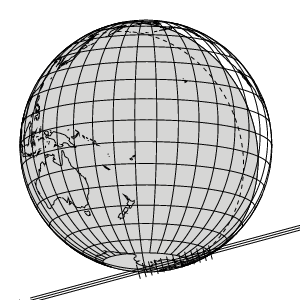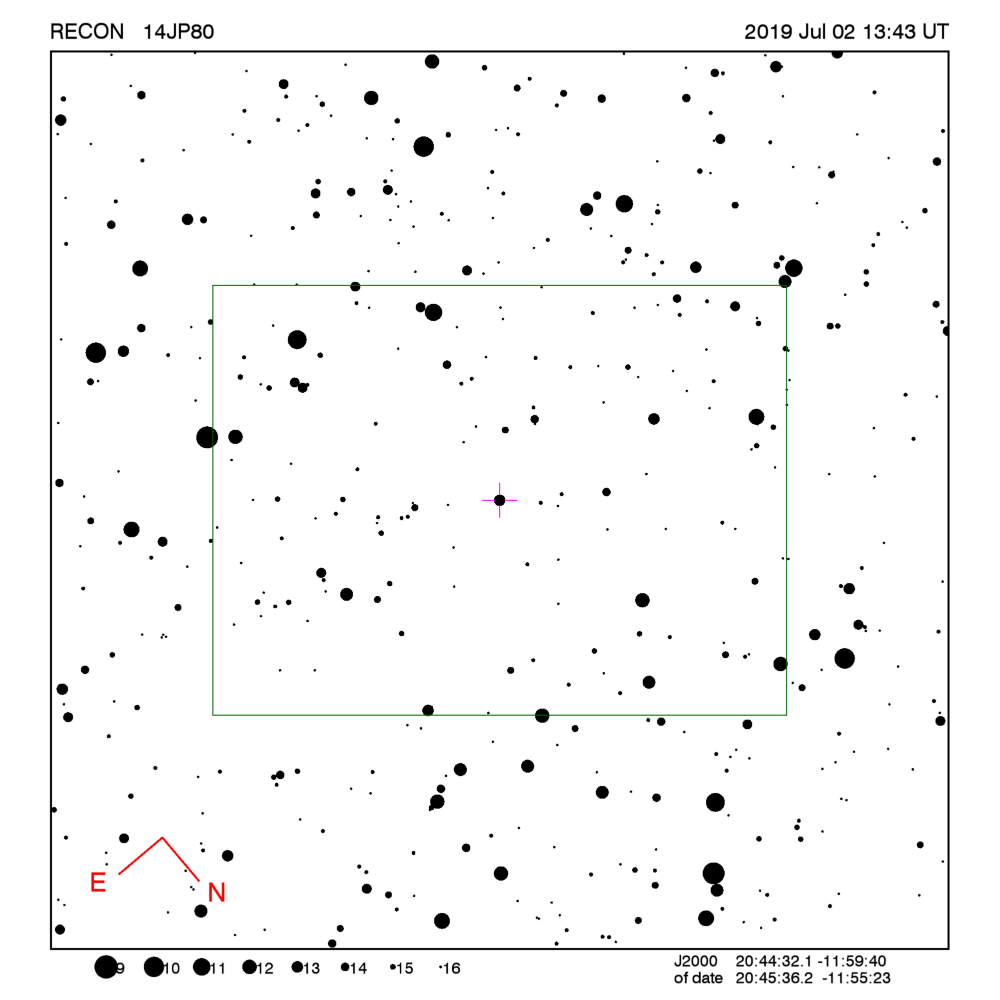RECON: TNO occultation with 14JP80
Event between 14JP80 and star GA0780:21593539
with event index number of 312113
Geocentric closest approach at 2019/07/02 13:42:54 UTC
J2000 position of star is 20:44:32.1 -11:59:40
Equinox of date position of star is 20:45:35.9 -11:55:23
Stellar brightness G=13.2,
use SENSEUP=32
Star is 147 degrees from the moon.
Moon is 0% illuminated.
TNO apparent brightness V=21.4
 TNO is 42.2 AU from the Sun
and 41.3 AU from the Earth.
TNO is 42.2 AU from the Sun
and 41.3 AU from the Earth.
The TNO is moving 21.1
km/sec on the sky relative to the star, or,
2.5 arcsec/hr.
The 1-sigma error in the time of the event is 94 seconds.
The 1-sigma cross-track error in the shadow position is
1607 km.
The TNO has an absolute magnitude Hv=5.1
Diameter=567.6 km assuming a 5% albedo -- 26.9 sec chord
Diameter=231.7 km assuming a 30% albedo -- 11.0 sec chord
Dynamical classification is 3:2E
Star training set for 14JP80, (2019/07/02 13:43UT)
Object RA Dec mag sep mel
Fomalhaut 22:58:43.5 -29:31:07 1.2 35.55 121
Tarazed 19:47:11.2 +10:39:43 2.7 26.84 142
PPM 237993 20:51:46.1 -12:28:17 5.9 1.60 146
PPM 237849 20:45:13.1 -11:31:57 8.4 0.40 147
PPM 237865 20:46:02.2 -12:06:26 9.5 0.21 147
14JP80 20:45:36.2 -11:55:23 13.2 146
Positions are for equinox of date

Azimuth is measured in degrees eastward from north.
North is at an azimuth of 0, due East is at an azimuth
of 90 degrees, due South is 180, and due West is 270.
Do not use the listing below for the RECON CPC 1100 telescopes.
This is provided for other non-team facilities.
Star training set for 14JP80, (2019/07/02 13:43UT)
Object RA Dec mag sep mel
Fomalhaut 22:57:39.5 -29:37:23 1.2 35.55 121
Tarazed 19:46:15.6 +10:36:48 2.7 26.84 142
PPM 237993 20:50:41.9 -12:32:43 5.9 1.60 146
PPM 237849 20:44:09.2 -11:36:14 8.4 0.40 147
PPM 237865 20:44:58.0 -12:10:44 9.5 0.21 147
14JP80 20:44:32.1 -11:59:40 13.2 147
Positions are for J2000
Event circumstances last updated at 2019/06/07 22:21:48 UT
Marc W. Buie,
Southwest Research Institute
RECON
 TNO is 42.2 AU from the Sun
and 41.3 AU from the Earth.
TNO is 42.2 AU from the Sun
and 41.3 AU from the Earth.
